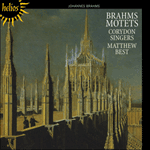
Welcome to Hyperion Records, a British classical label devoted to presenting high-quality recordings of music of all styles and from all periods from the twelfth century to the twenty-first.
Hyperion offers both CDs, and downloads in a number of formats. The site is also available in several languages.
Please use the dropdown buttons to set your preferred options, or use the checkbox to accept the defaults.

| Corydon Singers, Matthew Best (conductor)» More |
‘Es ist das Heil uns kommen her’ is richly scored in five parts (divided basses), consisting of a chorale harmonization (cf Op 74 No 2), followed by an extended Allegro fugal setting based on the main chorale melody. Brahms alleviates the relatively conventional approach to harmony by the subtle use of a number of archetypal chromatic inflections, most potently in the final bars, intensified by their suspension over a tonic E pedal point in the bass.
‘Schaffe in mir, Gott’, also with divided basses, opens with a canon (Andante moderato) in augmentation; that is to say, whilst the sopranos sing their melody twice through, the basses simultaneously sing the identical melody but at half speed, the two parts finally meeting up at the end of the section. However, such is the resulting simplicity of musical utterance, that the casual listener would hardly be aware of this intellectual conceit. ‘Verwirf mich nicht’ (Andante espressivo) is texturally more complex, exhibiting a transcendental contrapuntal mastery. Particularly notable is the exhilarating effect caused by the canonic interplay between the sopranos and tenors just before the end of this section, sending both parts soaring up to a top A flat within a beat of each other. The following ‘Tröste mich’ (Andante) is another canon, this time overlapping horizontally at the distance of one bar, and vertically by the interval of a seventh, appearing initially between tenors and second basses. This leads directly into the final section (‘und der freudige’—Allegro) which, with its thrilling sequences of running thirds, ends the motet in a mood of resounding affirmation.
from notes by Julian Haylock © 1991
«Schaffe in mir, Gott», qui est aussi composé avec des basses divisées, débute par un canon (Andante moderato) en augmentation; c’est-à-dire que pendant que les sopranos chantent deux fois leur mélodie en entier, les basses chantent simultanément l’identique mélodie à une vitesse réduite de moitié, et les deux parties se rejoignent finalement à la fin de la section. «Verwirf mich nicht» (Andante espressivo) est de texture plus complexe et fait preuve d’une maîtrise transcendantale du contrepoint. Il faut noter en particulier l’effet stimulant produit par le jeu canonique entre les sopranos et les ténors, juste avant la fin de cette section, qui semble lancer les deux parties en flèche vers un la bémol aigu qu’elles atteignent à moins d’un battement de mesure l’une de l’autre. Le verset suivant, «Tröste mich» (Andante) est un autre canon, cette fois-ci se chevauchant horizontalement avec une mesure de distance et verticalement avec un intervalle d’une septième; son apparence initiale est entre les ténors et les secondes basses. Ceci mène directement dans la section finale («und der freudige»—Allegro) qui termine le motet dans un mode d’affirmation retentissante, avec ses séquences saisissantes de tierces tombantes.
extrait des notes rédigées par Julian Haylock © 1991
Français: Alain Midoux
„Schaffe in mir, Gott“, bei dem ebenfalls die Bässe aufgeteilt sind, setzt mit einem Augmentationskanon (Andante moderato) ein; das ist so zu verstehen, daß die Soprane ihre Melodie zweimal durchsingen, während die Bässe simultan die gleiche Melodie singen, jedoch mit halber Geschwindigkeit, bis beide Stimmen am Ende des Abschnitts zusammentreffen. „Verwirf mich nicht“ (Andante espressivo) ist vom Aufbau her komplexer und läßt erhabene kontrapunktische Meisterschaft erkennen. Besonders bemerkenswert ist der belebende Effekt, den das kanonische Wechselspiel zwischen Sopranen und Tenören kurz vor dem Ende dieses Abschnitts auslöst, der beide Stimmen veranlaßt, sich im Abstand von nur einem Taktschlag zu einem hohen As emporzuschwingen. Das nachfolgende „Tröste mich“ (Andante) ist wiederum ein Kanon, der diesmal horizontal im Abstand von einem Takt überlappt, vertikal um eine Septime versetzt ist und zunächst zwischen Tenor und zweiter Baßstimme in Erscheinung tritt. Daran schließt sich unmittelbar der Schlußteil an („und der freudige“—Allegro), der mit seinen begeisternden Folgen abfallender Terzen die Motette in einer Atmosphäre widerhallender Bekräftigung ausklingen läßt.
aus dem Begleittext von Julian Haylock © 1991
Deutsch: Anne Steeb/Bernd Müller
 Brahms: Motets Brahms: Motets‘A must for any serious collector’ (Organists' Review) ‘Ideal for the more adventurous listener who enjoys a ramble down the lesser-known by-ways of the musical repertoire’ (The Music Magazine)» More |

